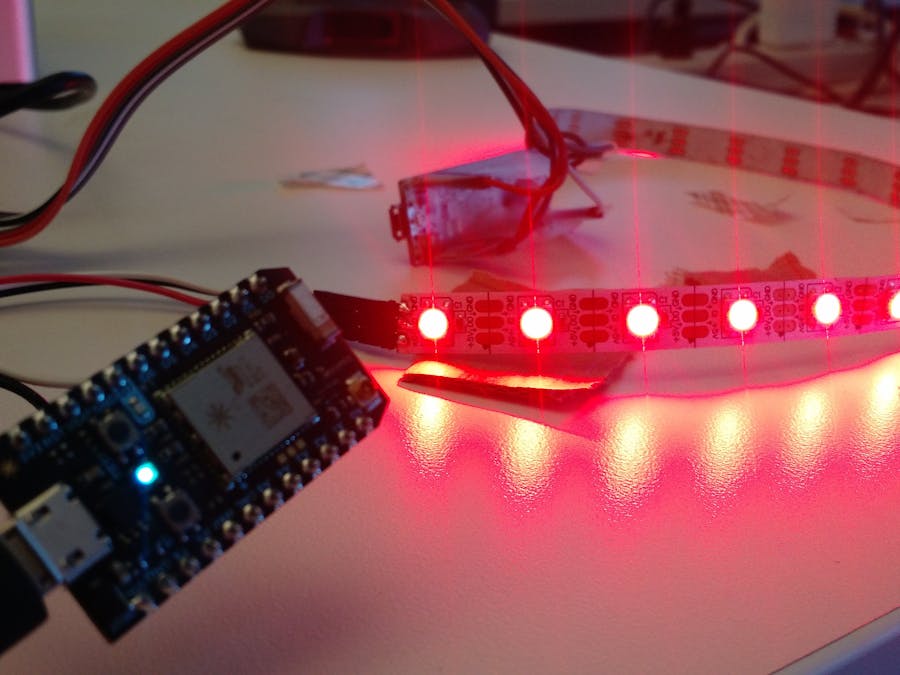/*-------------------------------------------------------------------------
Spark Core and Photon library to control WS2811/WS2812 based RGB
LED devices such as Adafruit NeoPixel strips.
Currently handles 800 KHz and 400kHz bitstream on Spark Core and Photon,
WS2812, WS2812B and WS2811.
Also supports:
- Radio Shack Tri-Color Strip with TM1803 controller 400kHz bitstream.
- TM1829 pixels
PLEASE NOTE that the NeoPixels require 5V level inputs
and the Spark Core and Photon only have 3.3V level outputs.
Level shifting is necessary, but will require a fast device such as one
of the following:
[SN74HCT125N]
http://www.digikey.com/product-detail/en/SN74HCT125N/296-8386-5-ND/376860
[SN74HCT245N]
http://www.digikey.com/product-detail/en/SN74HCT245N/296-1612-5-ND/277258
Written by Phil Burgess / Paint Your Dragon for Adafruit Industries.
Modified to work with Spark Core and Photon by Technobly.
Contributions by PJRC and other members of the open source community.
Adafruit invests time and resources providing this open source code,
please support Adafruit and open-source hardware by purchasing products
from Adafruit!
--------------------------------------------------------------------*/
/* ======================= includes ================================= */
#include "application.h"
#include "neopixel/neopixel.h"
SYSTEM_MODE(AUTOMATIC);
/* ======================= prototypes =============================== */
void colorAll(uint32_t c, uint8_t wait);
void colorWipe(uint32_t c, uint8_t wait);
void rainbow(uint8_t wait);
void rainbowCycle(uint8_t wait);
uint32_t Wheel(byte WheelPos);
/* ======================= extra-examples.cpp ======================== */
// IMPORTANT: Set pixel COUNT, PIN and TYPE
#define PIXEL_COUNT 20
#define PIXEL_PIN D2
#define PIXEL_TYPE WS2812B
// Parameter 1 = number of pixels in strip
// Parameter 2 = pin number (most are valid)
// note: if not specified, D2 is selected for you.
// Parameter 3 = pixel type [ WS2812, WS2812B, WS2811, TM1803 ]
// note: if not specified, WS2812B is selected for you.
// note: RGB order is automatically applied to WS2811,
// WS2812/WS2812B/TM1803 is GRB order.
//
// 800 KHz bitstream 800 KHz bitstream (most NeoPixel products ...
// ... WS2812 (6-pin part)/WS2812B (4-pin part) )
//
// 400 KHz bitstream (classic 'v1' (not v2) FLORA pixels, WS2811 drivers)
// (Radio Shack Tri-Color LED Strip - TM1803 driver
// NOTE: RS Tri-Color LED's are grouped in sets of 3)
Adafruit_NeoPixel strip = Adafruit_NeoPixel(PIXEL_COUNT, PIXEL_PIN, PIXEL_TYPE);
// IMPORTANT: To reduce NeoPixel burnout risk, add 1000 uF capacitor across
// pixel power leads, add 300 - 500 Ohm resistor on first pixel's data input
// and minimize distance between Arduino and first pixel. Avoid connecting
// on a live circuit...if you must, connect GND first.
void setup() {
strip.begin();
strip.show(); // Initialize all pixels to 'off'
Spark.function("color", color); // Expose the color function
}
void loop() {
}
// The function exposed in the spark API
int color(String command){
if(command == "red"){
colorWipe(strip.Color(255, 0, 0), 50); // Red
}else if(command == "blue"){
colorWipe(strip.Color(0, 0, 255), 50);
}else if(command == "green"){
colorWipe(strip.Color(0, 255, 0), 50);
}else if(command == "rainbow"){
rainbow(20);
}else if(command == "clear"){
colorWipe(strip.Color(0, 0, 0), 50);
}
}
// Set all pixels in the strip to a solid color, then wait (ms)
void colorAll(uint32_t c, uint8_t wait) {
uint16_t i;
for(i=0; i<strip.numPixels(); i++) {
strip.setPixelColor(i, c);
}
strip.show();
delay(wait);
}
// Fill the dots one after the other with a color, wait (ms) after each one
void colorWipe(uint32_t c, uint8_t wait) {
for(uint16_t i=0; i<strip.numPixels(); i++) {
strip.setPixelColor(i, c);
strip.show();
delay(wait);
}
}
void rainbow(uint8_t wait) {
uint16_t i, j;
for(j=0; j<256; j++) {
for(i=0; i<strip.numPixels(); i++) {
strip.setPixelColor(i, Wheel((i+j) & 255));
}
strip.show();
delay(wait);
}
}
// Slightly different, this makes the rainbow equally distributed throughout, then wait (ms)
void rainbowCycle(uint8_t wait) {
uint16_t i, j;
for(j=0; j<256; j++) { // 1 cycle of all colors on wheel
for(i=0; i< strip.numPixels(); i++) {
strip.setPixelColor(i, Wheel(((i * 256 / strip.numPixels()) + j) & 255));
}
strip.show();
delay(wait);
}
}
// Input a value 0 to 255 to get a color value.
// The colours are a transition r - g - b - back to r.
uint32_t Wheel(byte WheelPos) {
if(WheelPos < 85) {
return strip.Color(WheelPos * 3, 255 - WheelPos * 3, 0);
} else if(WheelPos < 170) {
WheelPos -= 85;
return strip.Color(255 - WheelPos * 3, 0, WheelPos * 3);
} else {
WheelPos -= 170;
return strip.Color(0, WheelPos * 3, 255 - WheelPos * 3);
}
}














Comments